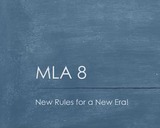
A video overview of MLA 8.
- Subject:
- Business and Communication
- Communication
- Education
- English Language Arts
- Material Type:
- Student Guide
- Author:
- Diana Tedone-Goldstone
- Date Added:
- 05/15/2019

A video overview of MLA 8.
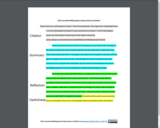
One example of a MLA Annotated Bibliography citation broken down into color-coded elements: Citation, Summary, Reflection, Usefulness.
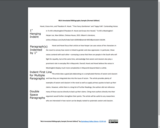
An example of a MLA Annotated Bibliography citation with minor notes on how it should be formatted.
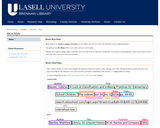
A basic guide to the most common uses of MLA style, including color-coded example citations.
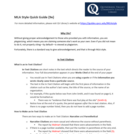
This is a general MLA Style Guide, ninth edition.
Most of the MLA material is brief and concise for a quick reference.
For more detailed information, please visit QV Library’s website at https://guides.qvcc.edu/MLAstyle
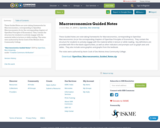
These Guided Notes are note-taking frameworks for Macroeconomics, corresponding to OpenStax Macroeconomics 2e (or the corresponding chapters of OpenStax Principles of Economics). They contain the structure for students to actively engage with the material while in lecture or while reading.
The notes were authored by Kevin Cook of Des Moines Area Community College.

Learners will identify sources of air pollution, explain the greenhouse effect, and detail procedures for improving and maintaining air quality. This represents a portion of the Introduction to Agriculture, Food, and Natural Resources (AFNR) series in Nebraska middle and high school agricultural education.

J'ai choisi la maison d'être car elle aidera les étudiants à comprendre avec quels verbes ils peuvent utiliser le passé composé lors de la conjugaison. La maison detre donne également aux étudiants de nombreux verbes différents se terminant par -er, -ir et -re.
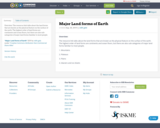
Overview: The resource link talks about the land forms that are known as the physical feature on the surface of the earth. The highest order of land forms are continents and ocean floors, but there are also sub-categories of major land forms familiar to most people.

Maker Clubs introduce students to the making movement, the idea that hands on learning and creating things from scratch lays the foundation for future success, especially in STEM fields.

This book will introduce you to the idea of Open Educational Resources (OER), where to find them, why we recommend using them, and how to go about creating your own.

This textbook was developed to meet two distinct yet related needs. The more basic goal was to respond to the paucity of teaching materials suited to the needs of U.S. learners of Malayalam, particularly at the university level. Though some materials had previously been produced both in India and in the US, including three sets of materials co-written by the author, none were at all suited to the needs and purposes of American university students. Some of the author is earlier materials were ad hoc in nature, while the 510-page course written for Peace Corps volunteers concentrated on language for daily social interactions only. Both the Peace Corps materials and most of the materials written in India were written in Roman
transcription, thus making no serious attempt to teach the Malayalam script or the skills of reading or writing.
The Malayalam ·materials produced in India by various scholars or teach~rs were not readily available in the West, and were moreqver designed for Indian learners for whom formal explanations of the grammar and culture are largely unnecessary, since many of the grammar and discourse conventions are similar or identical to those found in their own mother tongues. Thus the texts available at that time lacked much of what was essential to the Western learner of the language. A couple more sets of teaching materials have come out in: the intervening 20 years, and some may now be ordered via the Internet. A partial list of these materials appears in the prologue following lesson Twenty-five in this text. These books are, in
general, designed to prepare the learner to handle everyday living situations in Malayalam, and as such can be useful adjuncts once the present volume has been thoroughly studied.
This text was conceived and designed to go beyond social conversation to prepare the Western learner to use the language as a research tool. To meet this goal the skills pf literacy in Malayalam are essential, but this is only a beginning. It is also necessary to have some familiarity with the formal style of the language, used in most types of written matter and in platform and other types of formal speaking. This is still a need uniquely met by this text. The irony is that our student audience has grown and diversified, so that the textbook for the Malayalam classes here at Texas must serve two rather different types of students. There are still a number of graduate students who seek out Malayalam as a research tool for their academic work. fu the past dozen years or so the Malayalam classes are being taken by increasing numbers of second generation Malayalis who have either been born in North America or spent most of their lives here. They are normally undergraduates whose goals do not include doing academic research in Kerala. They are mainly interested in being able to communicate better with relatives in Kerala and their interest in literacy extends mainly to being able to
write letters to grandparents or other non-English-speaking relatives. The majority of lessons containing conversations with friends and family members in the book can still serve their purposes well.
The second need to be met by this textbook was that of a reference grammar which could be used by linguists to glean accurate information about various aspects of the Malayalam language such as its phonology, syntax (grammar), 'semantics, and discourse. This type of reference grammar could serve both specialists in other Dravidian languages, as well as general linguists examining a specific feature in many unrelated languages.
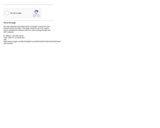
O Manual intuitivo de pigmentos amazônicos é um produto educacional voltado para o ensino das ciências ambientais, tendo como público alvo docentes e discentes do ensino básico. Apresenta conteúdos e elementos da região amazônica presentes no contexto dos educandos como o açaí, o camu-camu, buriti, solos amazônicos, além de textos com referência aos ecossistemas locais (várzea, terra firme e igapó). A proposta visa contribuir nas diversas modalidades de ensino, podendo ser usado como material didático nas escolas e nos espaços não formais, sendo passível de adaptações conforme a necessidade, conteúdo e faixa etária do educando.

This is a lesson about using evidence to construct sequences of geologic events. Learners will interpret real NASA science data to identify features on the surface of Mars, determine the surface history of the area, calculate the size of features, and develope investigable questions. Students will study images taken by NASA's Mars Thermal Emission Imaging System (THEMIS) camera orbiting Mars. Students will use the THEMIS images to analyze the surface features and geological history of Mars. The lesson models scientific inquiry using the 5E instructional model and includes teacher notes and vocabulary.

A small introductory definitions of Differential equations,order, degree formation of a DE and solutions of DE

These are full-course openly licensed resources for districts interested in exploring OER options when considering core instructional materials for district adoption. Course materials are available for online viewing or download.

The following information was shared via email by Kylie Hand to the members of the PA Student Centered Learning Network. It contains a review of the kick-off meeting, some suggested next steps for members of the group, and resources shared during the meeting.

This lesson was created in support of the Kick-Off meeting for the PA Student-Centered Learning Network. It contains easy access to links, information and overviews of the initiative, as well as links for the Kick-Off Meeting itself.
Measurement Conversion Chart

n this module you will learn the basics of Medical Math and how to calculate basic medication dosages. We cover the three methods for calculating simple dosages from physician orders: ratio and proportion, dimensional analysis and simple formulas. These files are SCORM packages and can be easily uploaded to your Learning Management System (LMS), such as Blackboard or Desire2Learn. If you want to view or use the files without an LMS, download the files to your computer, extract (unzip) the file, open the extracted folder, and click to open the story.html file. The booster or test will open in your browser window. If used on your LMS, for the booster, the user will be given a score of complete or incomplete; for the pre and post-tests, the user will be given a numerical score. This scoring functionality and completion data is only available if used on an LMS. The SCORM packages are complete and not available for editing. If you would like to include additional information, consider adding the content before or after the booster on your LMS.